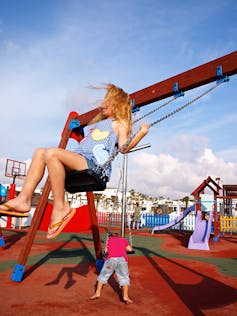It used to be said that the difficulty with parenting is that no-one gives you a manual, but you could argue that adage is no longer true.
From “tiger mums” to “attachment parents”, countless manifestos offer advice on how to successfully raise a child. In fact, there’s so much parenting advice around that first-time parents (in particular) can struggle to trust their own instincts and knowledge.
While book sales may be up, is there any scientific evidence to suggest better outcomes for children raised in any of these pop-culture parenting styles?
Hovering around
Most parenting research centres on “helicopter” parenting. Helicopter parents are so named because they hover above their children at all times, regularly swooping in to protect them from challenges and harm.
Anecdotes and media data don’t always present helicopter parents in the most flattering light, and the limited scientific research available appears to confirm this view.
One study found that, by adulthood, children of helicopter parents perceived poorer quality of communication with their parents compared with those whose parents were less helicopter-like. It also found these children had a heightened sense of personal entitlement.
Another study of college students found that those who reported helicopter parenting had lower levels of overall well-being and were more likely to be medicated for anxiety or depression, or both.
In contrast, a third study of young adults found the children of overly involved parents had better well-being scores than others. But their parents reported reduced life satisfaction due to their now-grown children still requiring intensive support.

Ploughing through
A close relative of the helicopter parent is another piece of parenting heavy machinery, the “snowplow” parent. This parent diligently removes all obstacles from their child’s path, eliminating challenge and hardship as best they can.
The idea is that by removing all obstacles, the child is free to focus on success and not be inhibited by failure. While the helicopter parent operates out of fear of something happening to their child, the snowplow parent just wants to make their child’s path in life easier.
There appears to be no empirical research on snowplow parenting yet, but both parenting styles could be defined as versions of over-protective parenting, about which there is some evidence.
Protection and over-protection
Research shows that children of over-protective parents are shyer toddlers, have more behavioural problems in childhood, higher depression scores in adolescence, and increased anxiety in adulthood.
Research also points to helicopter and over-protective parenting as being symptomatic of a family unit that is otherwise experiencing problems, which could include communication problems and broader unhappiness within the home.
A propensity to over-parent is associated with higher maternal anxiety; it can mean that the long-term relationship between parent and child can be damaged due to constant intrusion; and it may be difficult to sustain a healthy relationship between parents when so much focus is on the child.
Although this all sounds fairly dismal, it’s important to note that helicopter and snowplow parents behave in the way they do because they want the very best for their child. And this is a vitally important element of child development and well-being.
It’s just that, in their anxiety to ensure their child’s future success, these parents end up doing everything for their children instead of allowing them to develop independence and autonomy by doing tasks themselves.
Free ranging
If all this over-parenting sounds a little too intense, the “free range” parenting style may be the one for you. This is the parenting philosophy coined by Lenore Skenazy, who became known as “America’s Worst Mum” after publishing an opinion piece disclosing that her nine-year-old son was allowed to catch the New York subway on his own.

Like their chicken counterparts, free range kids are allowed to roam, unsupervised and outdoors. Skenazy argues that we live in safe times, the potential for harm to our children is far less than we perceive, and that it’s important for children to learn responsibility and independence early.
So at what age can children safely play outside alone? Answering that question gets to the heart of the difficulty with all these parenting styles and philosophies.
Every child is different, and each will develop requisite responsibility at a different rate. Each parent is different, and some will feel at home with their children playing somewhere down the street where others will only feel comfortable when they can see their child at all times.
There’s no universal rulebook but the basic theory of child development suggests that, at some point, the gradual development of autonomy and independence is one of the keys to a higher level of social and emotional well-being and future success. How and when that happens is up to each individual parent.
Monique Robinson, Associate Principal Investigator, Telethon Institute for Child Health Research, University of Western Australia
This article was originally published on The Conversation.















